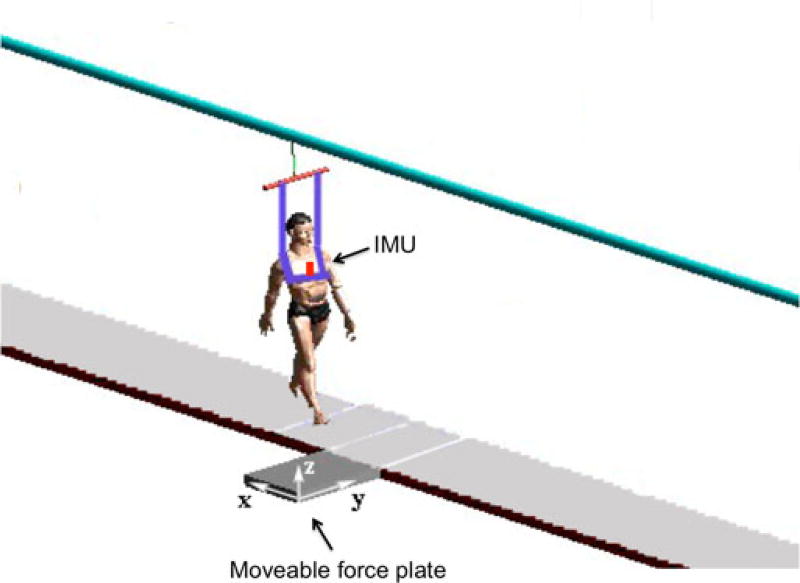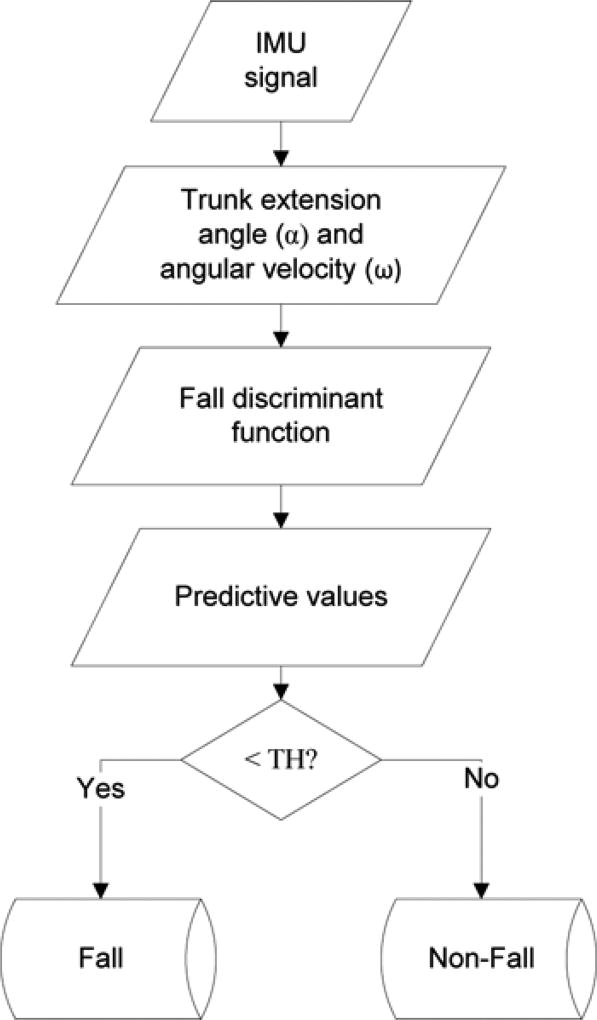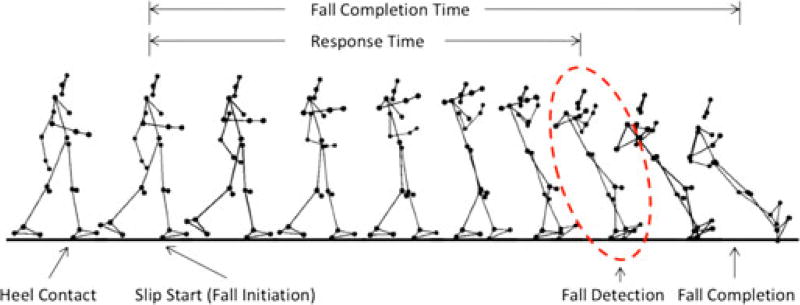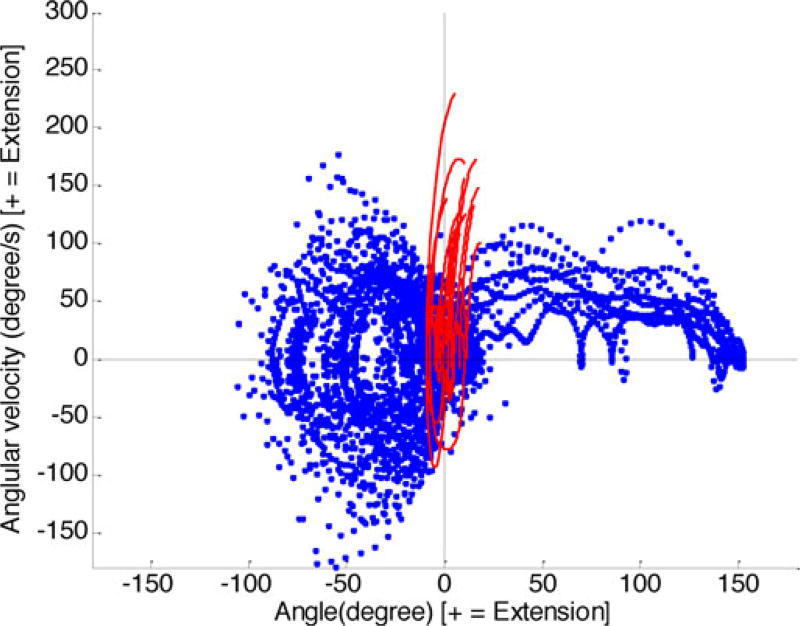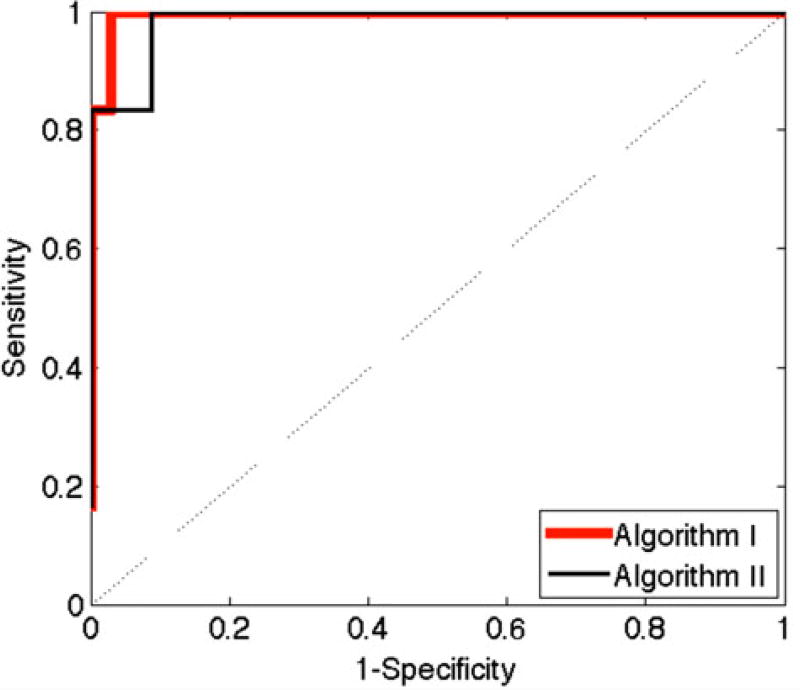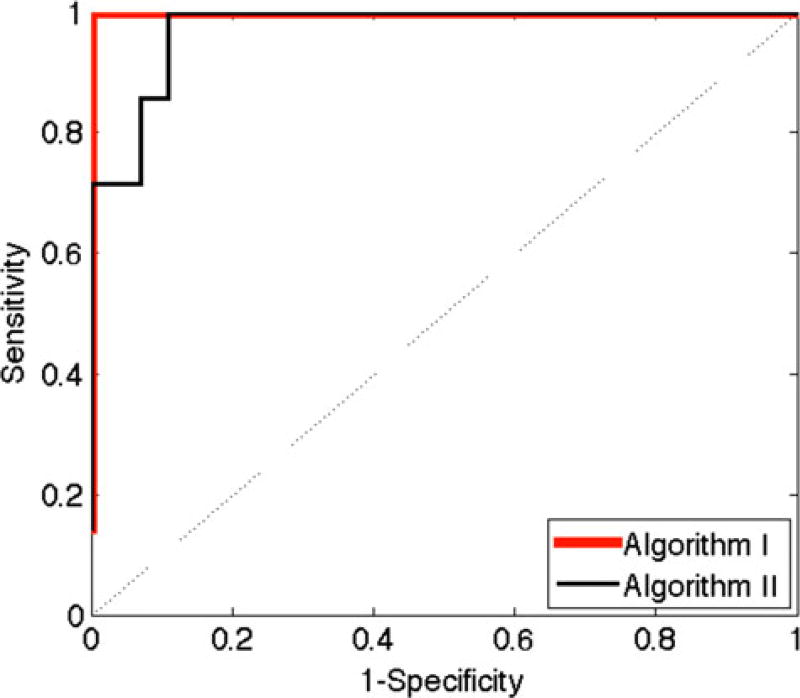Abstract
Automatic fall event detection has attracted research attention recently for its potential application in fall alarming system and wearable fall injury prevention system. Nevertheless, existing fall detection research is facing various limitations. The current study aimed to develop and validate a new fall detection algorithm using 2-D information (i.e., trunk angular velocity and trunk angle). Ten healthy elderly were involved in a laboratory study. Sagittal trunk angular kinematics was measured using inertial measurement unit during slip-induced backward falls and a variety of daily activities. The new algorithm was, on average, able to detect backward falls prior to impact, with 100% sensitivity, 95.65% specificity, and 255 ms response time. Therefore, it was concluded that the new fall detection algorithm was able to effectively detect falls during motion for the elderly population.
Index Terms: Fall detection, fall intervention, slips and falls
I. Introduction
FALLS are the leading cause of injury deaths among people 65 years and older. The National Safety Council reported that in 2007, 21 600 Americans met their death by falling, and of these deaths, the majority (over 80%) were people over 65 years of age [1]. Among all the causes leading to falls, slipping was considered as the most frequent unforeseen triggering event. Foot slippage was found to contribute between 40% and 50% of fall-related injuries [2], and 55% of the falls on the same level [3].
Among all the fall intervention approaches, automatic fall event detection has attracted research attention recently [4], for its potential application in fall alarming system and fall impact prevention system (e.g., wearable airbag [5], [6]). Nevertheless, the existing approaches have not satisfied the accuracy and robustness requirements of a satisfactory fall detection system [7].
Nevertheless, existing fall detection research is facing three major problems. The first problem is concerned with detection performance, more specifically the balance between misdetection and false alarms. Due to the heterogeneity of between-subject motion features and ambiguity of within-subject activity characteristics, higher fall detection sensitivity is always found to be associated with higher false alarm rates [8]. Almost all of the current fall detection techniques are facing this issue to a varying degree. The second problem is that the target of detection is unclear. Different devices may actually detect the impact of a fall, the incapacity to rise/recover after a fall (postfall impact), or the fall itself (the postural disturbance prior to the fall impact). From the perspective of preventing fall injuries directly using a wearable protection system, timely and accurate detection of a fall event prior to an impact is of utmost importance. Unfortunately, very few studies have been conducted in this area [8], [9]. Last but not least, most fall detection methods were developed using simulated falls. Recent research has clearly indicated the performance decrement when testing the existing detection algorithm with real-world falls [10]. Fall detection research with naturalistic falls due to balance perturbations is very limited [11], [12].
The rationale behind fall detection is that people often execute voluntary activities [e.g., activities of daily living (ADLs)] in a controlled manner, as suggested by Wu [5]. This is reflected mainly in terms of motion intensity [5], [9], [13]. In other words, abrupt motion (with high speed or acceleration) may very likely be an involuntary activity such as falling. This idea is, explicitly or implicitly, the basis for various detection algorithms and sensors used by different investigators [7], [14], [15]. However, as evident in these studies, motion intensity alone is not a sufficient criterion to differentiate between falling and ADLs. For example, Nyan et al. [14] utilized trunk backward angular velocity to detect fall events. Though a perfect sensitivity (100%) was demonstrated, frequent false alarms (5 out of 20 trials) were observed during bending down and standing up.
Therefore, the objective of the current study was to develop and validate a fall detection algorithm using 2-D information (i.e., trunk angular velocity ω and trunk angle α). Unexpected slip-induced falls were used for algorithm development and validation. It was hypothesized that the new algorithm would have significantly lower response time than the baseline algorithm [14]. Lower response time would indicate less time delay between the detected event and the actual fall.
II. Methods
A. Subjects
Ten elderly participants (age = 75 ± 6 years, weight = 74.1 ± 9.1 kg, height = 174 ± 7.5 cm) were recruited for this study. They were required to be in good physical health and free from any major musculoskeletal disorders (e.g., knee or hip replacement, osteoporosis, etc.) as screened by the study physician. Informed consent was approved by the local Institutional Review Board and obtained from the participants prior to the experiment.
B. Apparatus
One Inertial Measurement Unit (IMU, Inertia-Link, MicroStrain, Inc., USA) was placed close to the sternum (see Fig. 1). The inertia link is a miniature orientation sensor, which is capable of measuring 3-D orientation, 3-D acceleration, and 3-D angular velocity. The sampling rate was set to be 100 Hz.
Fig. 1.
Illustration of fall experiment setup (IMU: inertial measurement unit).
An adapted biomechanical model [16] with one additional marker on the sternum was used in this study. A six-camera infrared motion capture system (ProReflex MCU 240, Qualisys, Gothenburg, Sweden) was used to measure the 3-D position of the reflective markers. The sampling frequency was 100 Hz. The vertical position of the marker on the sternum was used to identify the motion phases of falling.
A linear walking track with movable floor surfaces was used to create slip-induced falls. An overhead harness system was used to prevent the participants’ other body parts except feet from hitting the ground. Typical household furniture (i.e., bed, desk, chair, etc.) was used to allow the participant to perform daily activities in a seminaturalistic living environment.
C. Procedure
Participants were required to change into experimental attire (e.g., short, sleeveless shirt, and athletic shoes) to facilitate the attachment of IMUs and reflective markers. An ADL protocol composing of five activities (i.e., bending over, lying down, sitting down on a normal chair, sitting into a rocking chair, sitting into a bucket seat) was performed by all the participants. Each ADL activity was performed three times. The order of all the ADLs activities was randomized using a balanced Latin-square design. The participants were instructed to perform these ADLs “as naturally as possible” at their own pace.
After the ADL session, a separate walking and fall session was conducted. Details on the walking and slip-induced fall-protocol can be found in our previous publications [17]. Briefly, unexpected slips were induced by having the participants walk over a slippery surface (covered with 3:1 personal lubricant and water mixture) without their awareness. The overhead harness was adjusted to allow the participants to fall up to 20 cm vertically in case they lost balance.
D. Data Reduction
All of the participants were randomly assigned into two groups. The data from the first group (four participants) were used as the training dataset to construct the new detection algorithm. The data from the second group (six participants) were used as the validation dataset to validate the detection performance.
The logic flow of the new detection algorithm is illustrated in Fig. 2. The quadratic form of predictive discriminant analysis [18] was performed on the training dataset in order to derive the discriminant function, F(α, ω), for the new algorithm (Algorithm I). The discriminant function provides a numerical way to differentiate fall trials from ADL trials. As a composite score integrating both α and ω, the detection threshold is not associated with any physical meaning. The optimal detection threshold for Algorithm I was determined based on the relationship between threshold and sensitivity/specificity [12], and the following rules.
Fig. 2.
Illustration of fall detection algorithm.
If a specific threshold (or a range of thresholds) could achieve the highest sensitivity and the highest specificity simultaneously, this threshold (or the midpoint of that range of thresholds) was selected as the optimal detection threshold for the new algorithm.
If no threshold could achieve the highest sensitivity and the highest specificity simultaneously, the optimal threshold for that algorithm had to satisfy: 1) specificity over 95% and 2) the highest sensitivity. In case that no threshold could achieve specificity over 95%, the optimal threshold for the algorithm was set to be a threshold associated with the highest specificity with nonzero sensitivity.
The baseline algorithm (Algorithm II) was formulated from the literature [14]. The associated discriminant function, F(ω), is in the form of
| (1) |
where ω is the trunk sagittal angular velocity.
The optimal threshold for the baseline algorithm is set to be −130°/s [14].
To facilitate the description of the fall dynamics, the following events (i.e., fall initiation, fall detection, fall completion) were defined and are illustrated in Fig. 2. Fall initiation was defined similar to slip start [16], which is the instant when the forward heel velocity occurred after heel contact. Fall detection was defined as the instant when the fall detection algorithm first recognized a fall trial. Fall completion was defined as the instant when the trunk center-of-mass reached its lowest vertical position.
The response time (a detection performance measure) was defined as the duration between fall initiation and fall detection (see Fig. 3). This variable was used to quantify how much time would be required for a fall to be detected after it was initiated.
Fig. 3.
Illustration of slip-induced backward fall.
Receiver operating characteristic (ROC) analysis was performed at the activity level to quantify the overall performance of the new algorithm and the baseline algorithm. Briefly, one data trial (i.e., a group of data points) was associated with one group attribute (i.e., fall or ADL). During detection, if a fall was detected at any instant within one trial, then the detection outcome for this data trial was assigned as fall. Otherwise, the detection outcome for that data trial was assigned as ADL. Sensitivity and specificity were calculated to quantify the rate of correctly detected falls relative to the total amount of actual falls, and the rate of correctly detected ADLs relative to the total amount of ADLs, respectively. Both sensitivity and specificity were computed at the trial level. Subsequently, area under curve (AUC) was calculated to quantify the overall detection performance of both the baseline and the new algorithms.
All of the data processing was performed in a local computer using a custom-designed MATLAB program (R2012 a, MathWorks, USA).
E. Statistical Analysis
A one-way within-subject ANOVA was conducted with the algorithm (Algorithms I and II) as the within-subject independent variable and the response time (from all ten subjects) as the dependent variable. A significant level of p ≤ 0.05 was used for hypothesis testing. All the statistical analyses were performed in JMP 10.0 (SAS Institute, USA).
III. Results
Totally, 179 ADL trials and 13 backward falls were collected and analyzed in the current study. The trunk sagittal angular kinematics from all the ADL trials and backward falls are illustrated in Fig. 4. The data points in this phase plot were the basis for the discriminant analysis. As shown, backward falls were characterized by a simultaneous occurrence of an extremely high trunk extension angular velocity and a slight trunk extension angle, which were clearly distinguishable from ADLs.
Fig. 4.
Composite illustration of trunk angular phase plots from all the ADL trials (indicated by dots) and all the backward fall trials (indicated by lines).
For the purpose of algorithm generation, four participants’ data (69 ADL trials and 6 slip-induced backward falls) were used as the training dataset and analyzed for deriving the fall discriminant function. The discriminant function for the new algorithm was found to be:
| (2) |
where a specific data trial was detected as a fall if any joint instantaneous values (α and ω) of this trial was less than a predetermined detection threshold. Otherwise, this data trial was detected as nonfall. The optimal detection threshold was determined to be −4.994, as this threshold satisfied the requirements of achieving the highest sensitivity while maintaining specificity over 95%. The effect of detection threshold on sensitivity and specificity can be found in our previous publication [12]. In particular, the sensitivity and specificity associated with this algorithm configuration were 100% and 95.65%, respectively.
The overall discrimination performance of the new algorithm and the baseline algorithm is illustrated in Fig. 5. As shown, the new algorithm achieved a very high discrimination performance, with an AUC of 0.9952, approaching an ideal performance level (AUC = 1.0). Though being slightly lower than that of new algorithm, the performance of baseline algorithm was also very high, with an AUC of 0.9855.
Fig. 5.
Activity ROC curves of Algorithms I (new algorithm) and II (baseline algorithm) using training dataset.
For the purpose of validation, the remaining six participants’ data (105 ADL trials and 7 slip-induced backward fall trials) were used as the validation dataset and processed by the new algorithm and the baseline algorithm.
The overall discrimination performances of the Algorithms I and II for the validation dataset are illustrated in Fig. 6. The performance of the Algorithm I using the validation dataset (AUC = 1.0) was slightly higher than that using the training dataset (AUC = 0.9952). For Algorithm II, the performance with the validation dataset (0.9743) was slightly lower than that with the training dataset (0.9855).
Fig. 6.
Activity ROC curves of Algorithms I (new algorithm) and II (baseline algorithm) using validation dataset.
The new algorithm achieved a slightly lower specificity with the validation dataset (95%) than with the training dataset (95.65%). In addition, the new algorithm achieved the same level of high sensitivity (100%) with both datasets. Similarly, the baseline algorithm resulted in a lower specificity with the validation dataset (90%) than with the training dataset (92.75%). However, the baseline algorithm achieved a higher sensitivity with the validation dataset (85.71%) than with the training dataset (83.33%).
Comparing the performance of different algorithms, Algorithm I was found to outperform Algorithm II by 14.29% in sensitivity, and 5% in specificity. In other words, the new algorithm using 2-D information (α and ω) resulted in better detection performance over the baseline algorithm using just one-dimension information (ω) in terms of higher sensitivity and specificity.
Response time was calculated by processing all the fall trials with both the new algorithm and the baseline algorithm. The ANOVA test indicated that the new algorithm was able to detect backward falls significantly faster than the baseline algorithm (p = 0.0002). On average, the response time from the new algorithm (Mean = 255 ms, SD = 22 ms) was 29 ms faster than that from the baseline algorithm (Mean = 284 ms, SD = 34 ms).
V. Discussions
Fall event detection is an important fall intervention solution as it helps reducing the fall-related injuries in an indirect manner and possibly in a direct manner (e.g., wearable protection system). Therefore, a prior-to-impact type of fall detection algorithm was developed and evaluated in the current study and was hypothesized to provide detection performance superior to those existing in research.
The findings from the current study indicated that the new algorithm achieved a high detection performance in terms of sensitivity and specificity. The performance was also validated by the validation dataset. Both sensitivity and specificity are important quantitative performance measures to evaluate the effectiveness of a fall detection algorithm [7]. Hence, these two measures were reported in most of the previous studies [4]. The performance of the new algorithm in the current study compared favorably to those in the literature [4]. The current study also evaluated the performance of the new detection algorithm side-by-side with a baseline algorithm from the literature [14], and found that the new algorithm performed better than the baseline algorithm.
The performance gain of the new algorithm can be attributed to its unique design that utilizes 2-D information. Previous studies [15], [19], [20] have also employed a multicriteria algorithm to detect a fall. Nevertheless, such multicriteria algorithms process the multidimensional measurements discretely, in a way that multiple 1-D measurements were processed either in a sequential manner, or in a parallel manner. In contrast, the 2-D measurements in the current study were utilized in an integrative manner. All of the information was analyzed in one discriminant function to generate one processed signal to be compared against one detection threshold.
Beside the detection performance improvements, the current study also has several methodological advantages over the previous studies. First, the elderly participants, instead of the young adults, were involved in the fall testing protocol in the current study. As reported in the literature [21], [22], the motion characteristics between young and elderly populations are expected to be different. Therefore, generalization of the testing results obtained from young participants to the elderly population should be made with caution. Second, the current study induced slip-induced backward falls during walking. For most of the previous studies [13], [15], [23], various types of falls were performed by the participants voluntarily falling from standing posture. More recently, more naturalistic falls due to balance perturbation have been incorporated in a few fall detection studies [11], [12]. The current study represents another effort to evaluate an algorithm in falls initiated during dynamic activity.
The new algorithm was also found to be able to successfully detect the fall event prior to the impact, with an average response time to be 255 ms. Response time has great implications in designing a wearable injury protection system. Being able to detect falls faster (i.e., shorter response time) or in other words, being able to provide more time (i.e., more lead-time) for a wearable protection system to function before the fall impact occurs is very critical to prevent/reduce impact-related injuries. Due to the safety concerns, no actual fall impact was allowed in the current study. Thus, the actual lead-time was not available from the current study.
The trunk segment was selected as the focus of the current study based on the practical consideration that trunk segment was an ideal site of ambulatory sensor attachment. It is agreed by many researchers that the trunk segment is the optimal location for a fall detector due to its proximity to the body’s center of mass and acceptable user compliance [13], [24]. Nevertheless, the upper arms, shanks, and head could also be desirable body sites for fall detectors attachment [25].
The new algorithm, in essence, is a threshold technique. It may be argued that other classification techniques should be adopted in developing a fall detection algorithm. These techniques may include neural networks [26], wavelet technique [27], [28], and so on. However, as explained in details by Karantonis et al. [29], the real-time and prior-to-impact nature of fall detection task imposed several constraints on choosing a classification technique and dictates the choice of threshold technique in the algorithm design.
As a proof of the concept, the current study was associated with various limitations and simplifications. First, the detection algorithm was developed specifically for backward falls. The backward falls were chosen in the current study mainly due to the fact that slipping was considered the most frequent unforeseen triggering event leading to majority of the falls on the same level [3]. In the future, it is certainly desirable to further enhance the detection algorithm for as many different types of falls as possible. Second, the fall dynamics in the current study was not complete due to the adoption of safety harness. In addition, the current study is also limited by small sample size and healthy elderly participants only. Future studies with a larger sample size and diverse participant populations would certainly enhance the external validity of the new fall detection algorithm. In addition, a fall detection with generic detection threshold may not be able to achieve the optimal performance at individual user level, which could be addressed by adopting an individual-specific detection model [11] or an automatic individual calibration concept [12].
In conclusion, the current study developed and validated a new fall detection algorithm, which is able to detect slip-induced backward falls prior to impact with high sensitivity and specificity. Such algorithm would be extremely useful toward developing a wearable fall injury protection system.
Acknowledgments
The paper’s contents are solely the responsibility of the authors and do not necessarily represent the official views of the National Institute of Health.
This work was supported by the National Institute of Health under Grant L30AG022963-02A1.
Footnotes
Color versions of one or more of the figures in this paper are available online at http://ieeexplore.ieee.org
Contributor Information
Jian Liu, Division of Applied Science and Technology, Marshall University, Huntington, WV 25755 USA.
Thurmon E. Lockhart, Grado Department of Industrial and Systems Engineering, Virginia Tech, Blacksburg, VA 24060 USA
References
- 1.National Safety Council. Injury Facts. Itasca, IL, USA: 2009. [Google Scholar]
- 2.Courtney TK, Sorock GS, Manning DP, Collins JW, Holbein-Jenny MA. Occupational slip, trip, and fall-related injuries—Can the contribution of slipperiness be isolated? Ergonomics. 2001 Oct.44:1118–1137. doi: 10.1080/00140130110085538. [DOI] [PubMed] [Google Scholar]
- 3.SWEA. Swedish Work Environment Authority and Statistics. Stockholm, Sweden: 2000. Occupational disease and occupational accidents 1998. [Google Scholar]
- 4.Noury N, Rumeau P, Bourke AK, Olaighin G, Lundy JE. A proposal for the classification and evaluation of fall detectors. Irbm. 2008 Dec.29:340–349. [Google Scholar]
- 5.Wu G. Distinguishing fall activities from normal activities by velocity characteristics. J. Biomech. 2000 Nov.33:1497–1500. doi: 10.1016/s0021-9290(00)00117-2. [DOI] [PubMed] [Google Scholar]
- 6.Tamura T, Yoshimura T, Sekine M, Uchida M, Tanaka O. A wearable airbag to prevent fall injuries. IEEE Trans. Inf. Technol. Biomed. 2009 Nov.13(6):910–914. doi: 10.1109/TITB.2009.2033673. [DOI] [PubMed] [Google Scholar]
- 7.Mubashir M, Shao L, Seed L. A survey on fall detection: Principles and approaches. Neurocomputing. 2013;100:144–152. [Google Scholar]
- 8.Nyan MN, Tay FEH, Murugasu E. A wearable system for pre-impact fall detection. J. Biomech. 2008;41:3475–3481. doi: 10.1016/j.jbiomech.2008.08.009. [DOI] [PubMed] [Google Scholar]
- 9.Wu G, Xue SW. Portable preimpact fall detector with inertial sensors. IEEE Trans. Neural Syst. Rehabil. Eng. 2008 Apr.16(2):178–183. doi: 10.1109/TNSRE.2007.916282. [DOI] [PubMed] [Google Scholar]
- 10.Bagala F, Becker C, Cappello A, Chiari L, Aminian K, Hausdorff JM, Zijlstra W, Klenk J. Evaluation of accelerometer-based fall detection algorithms on real-world falls. PLoS One. 7(5):e37062. doi: 10.1371/journal.pone.0037062. [DOI] [PMC free article] [PubMed] [Google Scholar]
- 11.Hu X, Qu X. An individual-specific fall detection model based on the statistical process control chart. Safety Sci. 2014;64:13–21. [Google Scholar]
- 12.Liu J, Lockhart TE. Automatic individual calibration in fall detection—An integrative ambulatory measurement framework. Comput. Methods Biomech. Biomed. Eng. 2013;16:504–510. doi: 10.1080/10255842.2011.627329. [DOI] [PMC free article] [PubMed] [Google Scholar]
- 13.Bourke AK, O’Brien JV, Lyons GM. Evaluation of a threshold-based tri-axial accelerometer fall detection algorithm. Gait Posture. 2007;26:194–199. doi: 10.1016/j.gaitpost.2006.09.012. [DOI] [PubMed] [Google Scholar]
- 14.Nyan MN, Tay FEH, Tan AWY, Seah KHW. Distinguishing fall activities from normal activities by angular rate characteristics and high-speed camera characterization. Med. Eng. Phys. 2006 Oct.28:842–849. doi: 10.1016/j.medengphy.2005.11.008. [DOI] [PubMed] [Google Scholar]
- 15.Lindemann U, Hock A, Stuber M, Keck W, Becker C. Evaluation of a fall detector based on accelerometers: A pilot study. Med. Biol. Eng. Comput. 2005 Sep.43:548–551. doi: 10.1007/BF02351026. [DOI] [PubMed] [Google Scholar]
- 16.Lockhart TE, Woldstad JC, Smith JL. Effects of age-related gait changes on the biomechanics of slips and falls. Ergonomics. 2003 Oct.46:1136–1160. doi: 10.1080/0014013031000139491. [DOI] [PMC free article] [PubMed] [Google Scholar]
- 17.Liu J, Lockhart TE. Age-related joint moment characteristics during normal gait and successful reactive-recovery from unexpected slip perturbations. Gait Posture. 2009;30:276–281. doi: 10.1016/j.gaitpost.2009.04.005. [DOI] [PMC free article] [PubMed] [Google Scholar]
- 18.Huberty CJ. Applied Discriminant Analysis. New York, NY, USA: Wiley; 1994. [Google Scholar]
- 19.Kangas M, Konttila A, Lindgren P, Winblad I, Jamsa T. Comparison of low-complexity fall detection algorithms for body attached accelerometers. Gait Posture. 2008;28:285–291. doi: 10.1016/j.gaitpost.2008.01.003. [DOI] [PubMed] [Google Scholar]
- 20.Kangas M, Vikman I, Wiklander J, Lindgren P, Nyberg L, Jamsa T. Sensitivity and specificity of fall detection in people aged 40 years and over. Gait Posture. 2009 Jun.29:571–574. doi: 10.1016/j.gaitpost.2008.12.008. [DOI] [PubMed] [Google Scholar]
- 21.Lajoie Y, Teasdale N, Bard C, Fleury M. Upright standing and gait: Are there changes in attentional requirements related to normal aging? Exp. Aging Res. 1996 Apr-Jun;22:185–198. doi: 10.1080/03610739608254006. [DOI] [PubMed] [Google Scholar]
- 22.Hsiao ET, Robinovitch SN. Common protective movements govern unexpected falls from standing height. J. Biomech. 1998 Jan.31:1–9. doi: 10.1016/s0021-9290(97)00114-0. [DOI] [PubMed] [Google Scholar]
- 23.Karamanidis K, Arampatzis A, Mademli L. Age-related deficit in dynamic stability control after forward falls is affected by muscle strength and tendon stiffness. J. Electromyogr Kinesiol. 2008 Dec.18:980–989. doi: 10.1016/j.jelekin.2007.04.003. [DOI] [PubMed] [Google Scholar]
- 24.Doughty K, Lewis R, McIntosh A. The design of a practical and reliable fall detector for community and institutional telecare. J. Telemed. Telecare. 2000;6:150–154. doi: 10.1258/1357633001934483. [DOI] [PubMed] [Google Scholar]
- 25.Hu X, Qu X. Differentiating slip-induced falls from normal walking and successful recovery after slips using kinematic measures. Ergonomics. 2013;56:856–867. doi: 10.1080/00140139.2013.776705. [DOI] [PubMed] [Google Scholar]
- 26.Kiani K, Snijders CJ, Gelsema ES. Recognition of daily life motor activity classes using an artificial neural network. Archives Phys. Med. Rehabil. 1998 Feb.79:147–154. doi: 10.1016/s0003-9993(98)90291-x. [DOI] [PubMed] [Google Scholar]
- 27.Nyan MN, Tay FEH, Seah KHW, Sitoh YY. Classification of gait patterns in the time-frequency domain. J. Biomech. 2006;39:2647–2656. doi: 10.1016/j.jbiomech.2005.08.014. [DOI] [PubMed] [Google Scholar]
- 28.Najafi B, Aminian K, Paraschiv-Ionescu A, Loew F, Bula C, Robert P. Ambulatory system for human motion analysis using a kinematic sensor: Monitoring of daily physical activity in the elderly. IEEE Trans. Biomed. Eng. 2003 Jun.50(6):711–723. doi: 10.1109/TBME.2003.812189. [DOI] [PubMed] [Google Scholar]
- 29.Karantonis DM, Narayanan MR, Mathie M, Lovell NH, Celler BG. Implementation of a real-time human movement classifier using a triaxial accelerometer for ambulatory monitoring. IEEE Trans. Inf. Technol. Biomed. 2006 Jan.10(1):156–167. doi: 10.1109/titb.2005.856864. [DOI] [PubMed] [Google Scholar]



